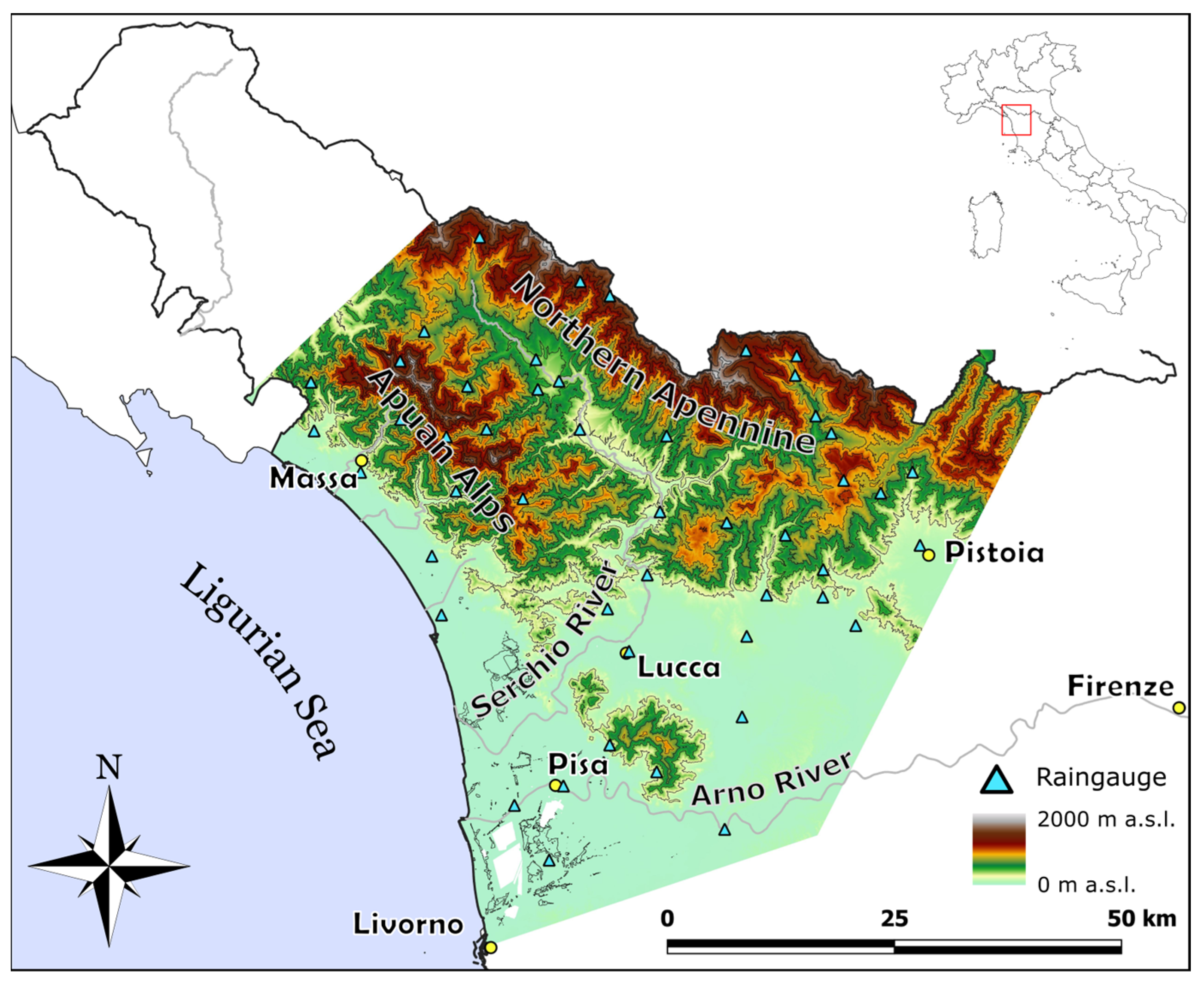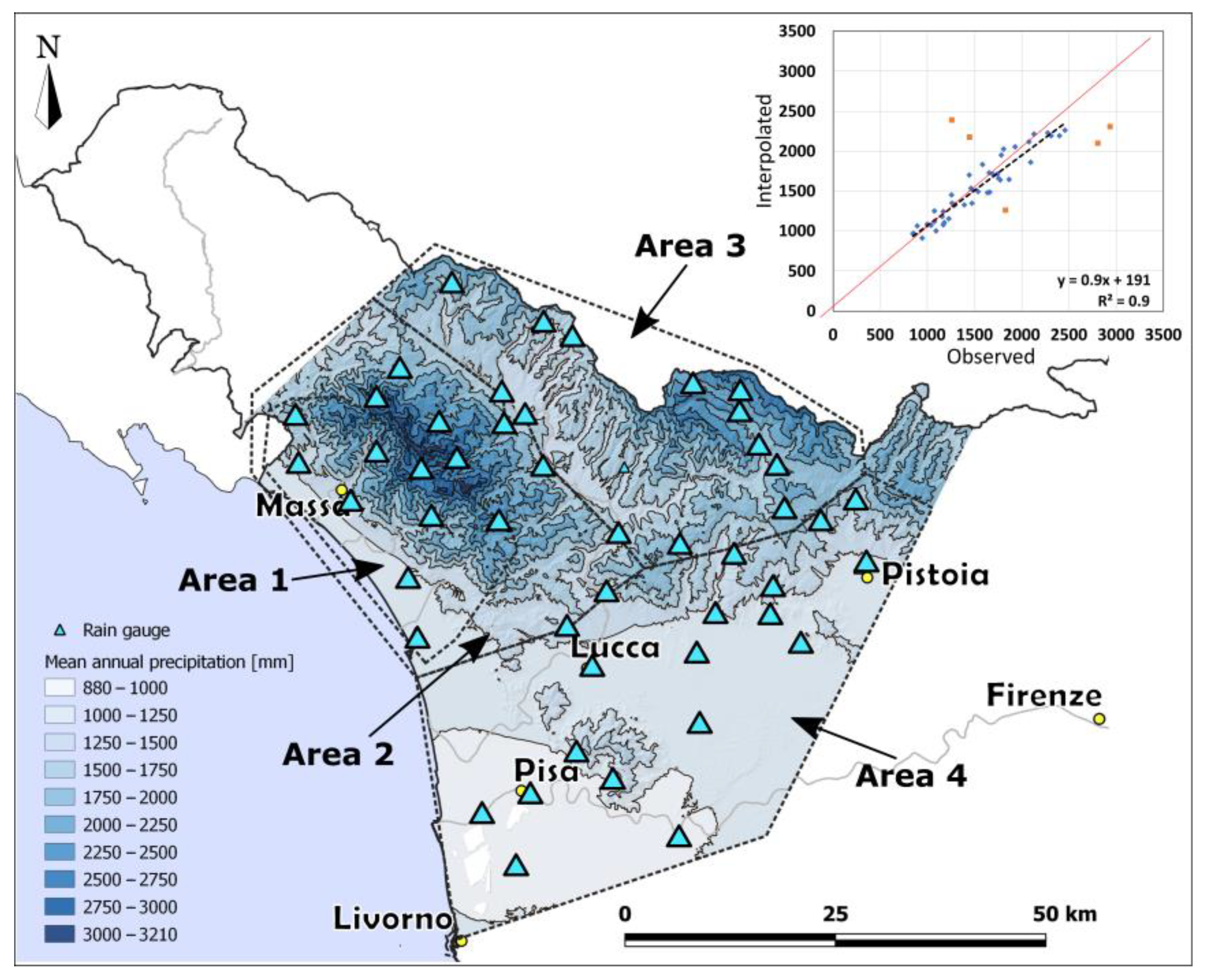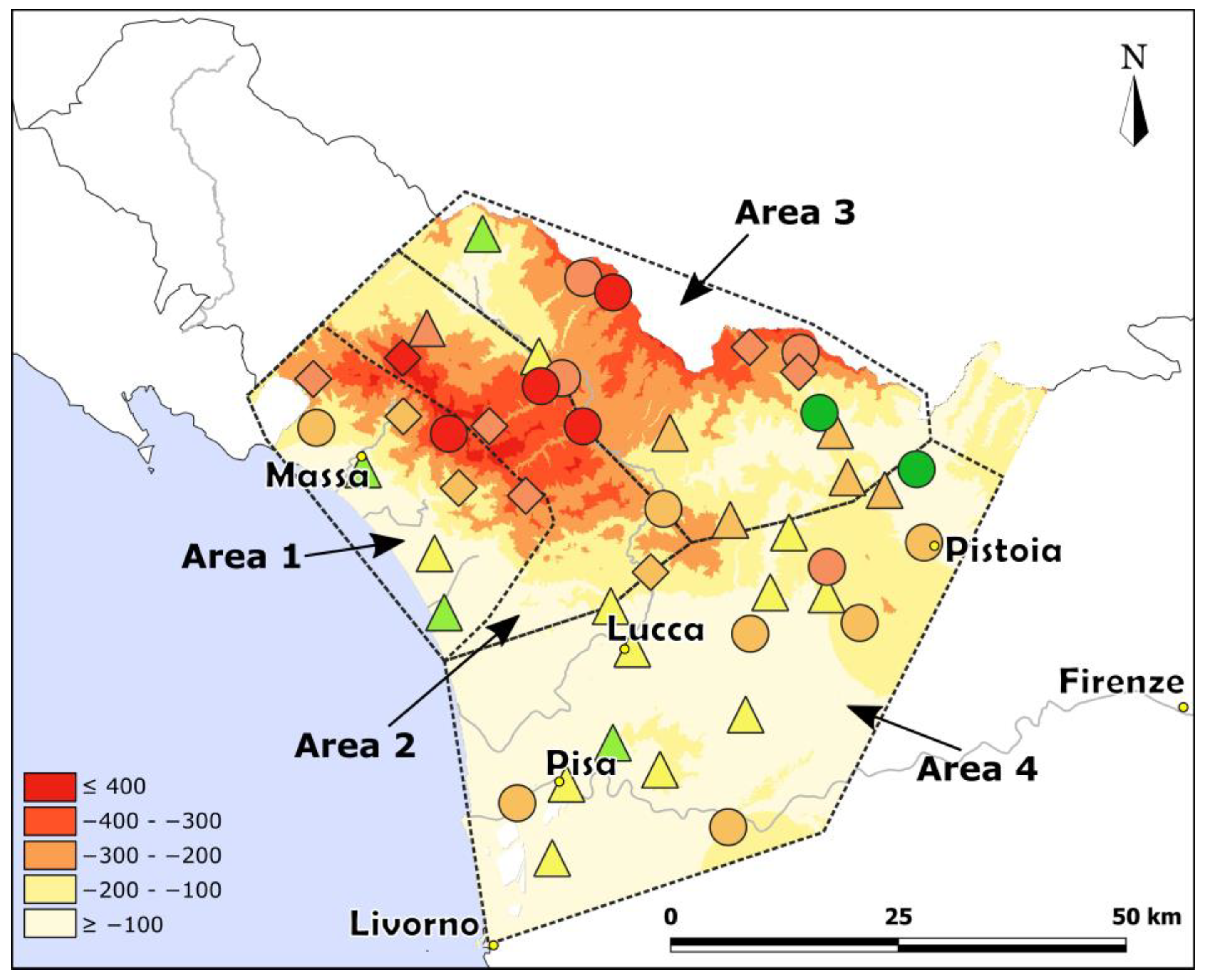Investigating a Century of Rainfall: The Impact of Elevation on Precipitation Changes (Northern Tuscany, Italy)
Abstract
1. Introduction
- o
- evaluation of the changes in annual precipitation and their spatial patterns in the study area over the last century;
- o
- analysis of how topography can influence precipitation changes at the local scale.
2. Study Area
3. Materials and Methods
3.1. Deriving and Checking Annual Precipitation Series
3.2. Precipitation Interpolation
3.3. Analysis of Annual Precipitation Variation
3.3.1. Trend Analysis
3.3.2. Differences in Mean Annual Precipitations
- —standard deviation of the difference in MAP between the periods x and y.
- —variance in the annual precipitation values in the period x or y.
- —number of observations in the x or y period.
3.4. Morphological and Geographical Influence on the Annual Precipitation Changes
4. Results
4.1. Annual Precipitation Fluctuations
4.2. Annual Precipitation Differences
4.3. The Effect of Elevation
4.4. Interpolation of Differences in Precipitation
5. Discussion
6. Conclusions
- −
- Annual precipitation was approximately stable during the 1921–1970 period.
- −
- Changes in precipitation were mostly negative from the 1970s to the beginning of the 1990s and positive but less marked from the 1990s onwards.
- −
- The mountainous areas showed a greater reduction in annual precipitation up to −400 mm over the observation period.
- −
- Over the Apuan Alps—the mountain ridge closer to the sea—the decrease in precipitation is negatively correlated with altitude. This correlation is absent over the innermost mountain ridge (northern Apennines).
Author Contributions
Funding
Data Availability Statement
Acknowledgments
Conflicts of Interest
References
- Dams, J.; Salvadore, E.; Van Daele, T.; Ntegeka, V.; Willems, P.; Batelaan, O. Spatio-Temporal Impact of Climate Change on the Groundwater System. Hydrol. Earth Syst. Sci. 2012, 16, 1517–1531. [Google Scholar] [CrossRef]
- IPCC. Climate Change 2022—Impacts, Adaptation and Vulnerability: Working Group II Contribution to the Sixth Assessment Report of the Intergovernmental Panel on Climate Change, 1st ed.; Cambridge University Press: Cambridge, MA, USA, 2023; ISBN 978-1-00-932584-4. [Google Scholar]
- Vörösmarty, C.J.; Green, P.; Salisbury, J.; Lammers, R.B. Global Water Resources: Vulnerability from Climate Change and Population Growth. Science 2000, 289, 284–288. [Google Scholar] [CrossRef] [PubMed]
- World Meteorological Organization. State of Global Water Resources Report. 2022 WMO-No. 1333; World Meteorological Organization (WMO): Geneva, Switzerland, 2023; p. 66. [Google Scholar]
- Bird, L.J.; Bodeker, G.E.; Clem, K.R. Sensitivity of Extreme Precipitation to Climate Change Inferred Using Artificial Intelligence Shows High Spatial Variability. Commun. Earth Environ. 2023, 4, 469. [Google Scholar] [CrossRef]
- IPCC. Climate Change 2007: The Physical Science Basis: Contribution of Working Group I to the Fourth Assessment Report of the Intergovernmental Panel on Climate Change; Solomon, S., Qin, D., Manning, M., Chen, Z., Marquis, M., Averyt, K.B., Tignor, M., Miller, H.L., Eds.; Intergovernmental Panel on Climate Change; Cambridge University Press: Cambridge, MA, USA, 2007; ISBN 978-0-521-88009-1. [Google Scholar]
- Kidd, C.; Huffman, G. Global Precipitation Measurement. Meteorol. Appl. 2011, 18, 334–353. [Google Scholar] [CrossRef]
- Adler, R.F.; Gu, G.; Sapiano, M.; Wang, J.-J.; Huffman, G.J. Global Precipitation: Means, Variations and Trends During the Satellite Era (1979–2014). Surv. Geophys. 2017, 38, 679–699. [Google Scholar] [CrossRef]
- Deitch, M.; Sapundjieff, M.; Feirer, S. Characterizing Precipitation Variability and Trends in the World’s Mediterranean-Climate Areas. Water 2017, 9, 259. [Google Scholar] [CrossRef]
- Easterling, D.R.; Arnold, J.R.; Knutson, T.; Kunkel, K.E.; LeGrande, A.N.; Leung, L.R.; Vose, R.S.; Waliser, D.E.; Wehner, M.F. Precipitation change in the United States. In Climate Science Special Report: Fourth National Climate Assessment, Volume I; Wuebbles, D.J., Fahey, D.W., Hibbard, K.A., Dokken, D.J., Stewart, B.C., Maycock, T.K., Eds.; U.S. Global Change Research Program: Washington, DC, USA, 2017; pp. 207–230. [Google Scholar] [CrossRef]
- Hu, Z.; Zhou, Q.; Chen, X.; Qian, C.; Wang, S.; Li, J. Variations and Changes of Annual Precipitation in Central Asia over the Last Century. Int. J. Climatol. 2017, 37, 157–170. [Google Scholar] [CrossRef]
- Minetti, J.L.; Vargas, W.M.; Poblete, A.G.; Acuña, L.R.; Casagrande, G. Non-Linear Trends and Low Frequency Oscillations in Annual Precipitation over Argentina and Chile, 1931–1999. Atmósfera 2003, 16, 119–135. [Google Scholar]
- Brunetti, M.; Maugeri, M.; Monti, F.; Nanni, T. Temperature and Precipitation Variability in Italy in the Last Two Centuries from Homogenised Instrumental Time Series. Int. J. Climatol. 2006, 26, 345–381. [Google Scholar] [CrossRef]
- De Luis, M.; Raventós, J.; González-Hidalgo, J.C.; Sánchez, J.R.; Cortina, J. Spatial Analysis of Rainfall Trends in the Region of Valencia (East Spain). Int. J. Climatol. 2000, 20, 1451–1469. [Google Scholar] [CrossRef]
- Pfister, L.; Drogue, G.; El Idrissi, A.; Iffly, J.-F.; Poirier, C.; Hoffmann, L. Spatial Variability of Trends in the Rainfall-Runoff Relationship: A Mesoscale Study in the Mosel Basin. Clim. Chang. 2004, 66, 67–87. [Google Scholar] [CrossRef]
- Zhai, Y.; Guo, Y.; Zhou, J.; Guo, N.; Wang, J.; Teng, Y. The Spatio-Temporal Variability of Annual Precipitation and Its Local Impact Factors during 1724–2010 in Beijing, China. Hydrol. Process. 2014, 28, 2192–2201. [Google Scholar] [CrossRef]
- Blanchet, J.; Creutin, J.-D.; Blanc, A. Retreating Winter and Strengthening Autumn Mediterranean Influence on Extreme Precipitation in the Southwestern Alps over the Last 60 Years. Environ. Res. Lett. 2021, 16, 034056. [Google Scholar] [CrossRef]
- Luppichini, M.; Bini, M.; Barsanti, M.; Giannecchini, R.; Zanchetta, G. Seasonal Rainfall Trends of a Key Mediterranean Area in Relation to Large-Scale Atmospheric Circulation: How Does Current Global Change Affect the Rainfall Regime? J. Hydrol. 2022, 612, 128233. [Google Scholar] [CrossRef]
- Napoli, A.; Crespi, A.; Ragone, F.; Maugeri, M.; Pasquero, C. Variability of Orographic Enhancement of Precipitation in the Alpine Region. Sci. Rep. 2019, 9, 13352. [Google Scholar] [CrossRef] [PubMed]
- Blanchet, J.; Blanc, A.; Creutin, J.-D. Explaining Recent Trends in Extreme Precipitation in the Southwestern Alps by Changes in Atmospheric Influences. Weather. Clim. Extrem. 2021, 33, 100356. [Google Scholar] [CrossRef]
- Dimri, A.P.; Palazzi, E.; Daloz, A.S. Elevation Dependent Precipitation and Temperature Changes over Indian Himalayan Region. Clim. Dyn. 2022, 59, 1–21. [Google Scholar] [CrossRef]
- Frei, C.; Schär, C. A Precipitation Climatology of the Alps from High-Resolution Rain-Gauge Observations. Int. J. Climatol. 1998, 18, 873–900. [Google Scholar] [CrossRef]
- Lionello, P.; Scarascia, L. The Relation between Climate Change in the Mediterranean Region and Global Warming. Reg. Environ. Chang. 2018, 18, 1481–1493. [Google Scholar] [CrossRef]
- Paeth, H.; Vogt, G.; Paxian, A.; Hertig, E.; Seubert, S.; Jacobeit, J. Quantifying the Evidence of Climate Change in the Light of Uncertainty Exemplified by the Mediterranean Hot Spot Region. Glob. Planet. Chang. 2017, 151, 144–151. [Google Scholar] [CrossRef]
- Tuel, A.; Eltahir, E.A.B. Why Is the Mediterranean a Climate Change Hot Spot? J. Clim. 2020, 33, 5829–5843. [Google Scholar] [CrossRef]
- Bartolini, G.; Messeri, A.; Grifoni, D.; Mannini, D.; Orlandini, S. Recent Trends in Seasonal and Annual Precipitation Indices in Tuscany (Italy). Theor. Appl. Clim. 2014, 118, 147–157. [Google Scholar] [CrossRef]
- D’Oria, M.; Ferraresi, M.; Tanda, M.G. Historical Trends and High-Resolution Future Climate Projections in Northern Tuscany (Italy). J. Hydrol. 2017, 555, 708–723. [Google Scholar] [CrossRef]
- Doveri, M.; Piccini, L.; Menichini, M. Hydrodynamic and Geochemical Features of Metamorphic Carbonate Aquifers and Implications for Water Management: The Apuan Alps (NW Tuscany, Italy) Case Study. In Karst Water Environment: Advances in Research, Management and Policy; Younos, T., Schreiber, M., Kosič Ficco, K., Eds.; The Handbook of Environmental Chemistry; Springer International Publishing: Cham, Switzerland, 2019; pp. 209–249. ISBN 978-3-319-77368-1. [Google Scholar]
- Menichini, M.; Doveri, M.; Piccini, L. Hydrogeological and Geochemical Overview of the Karst Aquifers in the Apuan Alps (Northwestern Tuscany, Italy). AS-ITJGW 2016, 5, 15–23. [Google Scholar] [CrossRef][Green Version]
- Bolle, H.-J. (Ed.) Mediterranean Climate; Springer: Berlin/Heidelberg, Germany, 2003; ISBN 978-3-642-62862-7. [Google Scholar]
- Lionello, P.; Malanotte-Rizzoli, P.; Boscolo, R.; Alpert, P.; Artale, V.; Li, L.; Luterbacher, J.; May, W.; Trigo, R.; Tsimplis, M.; et al. The Mediterranean Climate: An Overview of the Main Characteristics and Issues. In Developments in Earth and Environmental Sciences; Elsevier: Amsterdam, The Netherlands, 2006; Volume 4, pp. 1–26. ISBN 978-0-444-52170-5. [Google Scholar]
- Natali, S.; Baneschi, I.; Doveri, M.; Giannecchini, R.; Selmo, E.; Zanchetta, G. Meteorological and Geographical Control on Stable Isotopic Signature of Precipitation in a Western Mediterranean Area (Tuscany, Italy): Disentangling a Complex Signal. J. Hydrol. 2021, 603, 126944. [Google Scholar] [CrossRef]
- Fatichi, S.; Caporali, E. A Comprehensive Analysis of Changes in Precipitation Regime in Tuscany. Int. J. Climatol. 2009, 29, 1883–1893. [Google Scholar] [CrossRef]
- Bartolini, G.; Grifoni, D.; Magno, R.; Torrigiani, T.; Gozzini, B. Changes in Temporal Distribution of Precipitation in a Mediterranean Area (Tuscany, Italy) 1955–2013: Precipitation concentration changes in Tuscany (Italy) 1955–2013. Int. J. Clim. 2017, 38, 1366–1374. [Google Scholar] [CrossRef]
- Rapetti, F.; Vittorini, S. Note illustrative della carta climatica della Toscana. Atti Soc. Tosc. Sci. Nat. Mem. 2012, 117, 41–74. [Google Scholar]
- Giannecchini, R.; D’Amato Avanzi, G. Historical Research as a Tool in Estimating Hydrogeological Hazard in a Typical Small Alpine-like Area: The Example of the Versilia River Basin (Apuan Alps, Italy). Phys. Chem. Earth Parts A/B/C 2012, 49, 32–43. [Google Scholar] [CrossRef]
- Rapetti, F.; Vittorini, S. Aspetti del clima nei versanti tirrenico ed adriatico lungo l’allineamento Livorno-Monte Cimone-Modena. Atti Soc. Tosc. Sci. Nat. Mem. Ser. A 1989, 96, 159–192. [Google Scholar]
- Natali, S.; Doveri, M.; Giannecchini, R.; Baneschi, I.; Zanchetta, G. Is the Deuterium Excess in Precipitation a Reliable Tracer of Moisture Sources and Water Resources Fate in the Western Mediterranean? New Insights from Apuan Alps (Italy). J. Hydrol. 2022, 614, 128497. [Google Scholar] [CrossRef]
- SIR Settore Idrologico e Geologico Regionale. Available online: https://www.sir.toscana.it/index.php (accessed on 24 November 2022).
- WIND Gis WINDGIS—Sistema per la Valutazione del Potenziale Eolico Della Regione Toscana. Available online: http://159.213.57.103/lamma-webgis/windgis.phtml (accessed on 10 February 2023).
- Baroni, C.; Pieruccini, P. Geomorphological and Neotectonic Map of the Apuan Alps (TUSCANY, ITALY). Geogr. Fis. E Din. Quat. 2015, 38, 201–228. [Google Scholar] [CrossRef]
- Rapetti, F.; Vittorini, S. Carta Climatica Della Toscana Centro-Meridionale e Insulare (Scala 1:250.000); Pacini: Pisa, Italia, 1994. [Google Scholar]
- D’Amato Avanzi, G.; Galanti, Y.; Giannecchini, R.; Mazzali, A.; Saulle, G. Remarks on the 25 October 2011 Rainstorm in Eastern Liguria and Northwestern Tuscany (Italy) and the Related Landslides. Rend. Online Soc. Geol. It. 2013, 24, 76–78. [Google Scholar]
- D’Amato Avanzi, G.; Giannecchini, R.; Puccinelli, A. The Influence of the Geological and Geomorphological Settings on Shallow Landslides. An Example in a Temperate Climate Environment: The June 19, 1996 Event in Northwestern Tuscany (Italy). Eng. Geol. 2004, 73, 215–228. [Google Scholar] [CrossRef]
- Fagandini, C.; Todaro, V.; Tanda, M.G.; Pereira, J.L.; Azevedo, L.; Zanini, A. Missing Rainfall Daily Data: A Comparison Among Gap-Filling Approaches. Math. Geosci. 2024, 56, 191–217. [Google Scholar] [CrossRef]
- Paulhus, J.L.H.; Kohler, M.A. Interpolation of Missing Precipitation Records. Mon. Weather. Rev. 1952, 80, 129–133. [Google Scholar] [CrossRef]
- Searcy, J.K.; Hardison, C.H. Double Mass Curves: Manual of Hydrology: Part 1. General Surface Water Techniques; Water-Supply Paper 1541-B; US Geological Survey: Tacoma, WA, USA, 1960. [Google Scholar]
- R Core Team. R: A Language and Environment for Statistical Computing; R Foundation for Statistical Computing: Vienna, Austria, 2020; Available online: https://www.R-project.org/ (accessed on 27 August 2024).
- Hiemstra, P. Automatic Interpolation Package. 2024. Available online: https://cran.r-project.org/web/packages/automap/automap.pdf (accessed on 3 September 2024).
- Babish, G. Geostatistics without Tears. A Practical Guide to Geostatistics, Variograms and Kriging, 4.60th ed.; Environment Canada; Ecological Research Division Environmental Conservation Branch: Regina, SK, Canada, 2000. [Google Scholar]
- Clark, I. The Art of Cross Validation in Geostatistical Applications. In 19th Application of Computers and Operations Research in the Mineral Industry; Society of Mining Engineers, Inc: Littleton Colorado, CO, USA, 1986; Chapter 20; pp. 211–220. [Google Scholar]
- World Meteorological Organization. WMO Guidelines on the Calculation of Climate Normals; Chairperson, Publications Board World Meteorological Organization (WMO): Geneva, Switzerland, 2017. [Google Scholar]
- Kendall, M.G. Rank Correlation Methods, 4th ed.; Griffin: London, UK, 1970; ISBN 978-0-85264-199-6. [Google Scholar]
- Hirsch, R.M.; Slack, J.R. A Nonparametric Trend Test for Seasonal Data with Serial Dependence. Water Resour. Res. 1984, 20, 727–732. [Google Scholar] [CrossRef]
- Yue, S.; Pilon, P.; Cavadias, G. Power of the Mann–Kendall and Spearman’s Rho Tests for Detecting Monotonic Trends in Hydrological Series. J. Hydrol. 2002, 259, 254–271. [Google Scholar] [CrossRef]
- Cannarozzo, M.; Noto, L.V.; Viola, F. Spatial Distribution of Rainfall Trends in Sicily (1921–2000). Phys. Chem. Earth Parts A/B/C 2006, 31, 1201–1211. [Google Scholar] [CrossRef]
- Marchetto, A. Mann-Kendall Test, Seasonal and Regional Kendall Tests. 2021. Available online: https://cran.r-project.org/web/packages/rkt/rkt.pdf (accessed on 27 August 2024).
- Bevington, P.R.; Robinson, D.K. Data Reduction and Error Analysis for the Physical Sciences, 3rd ed.; McGraw-Hill: Boston, MA, USA, 2003; ISBN 978-0-07-247227-1. [Google Scholar]
- Canty, A.; Ripley, B. Boot: Bootstrap R (S-Plus) Functions. R Package Version 1.3-28.1. 2024. Available online: https://cran.r-project.org/web/packages/boot/boot.pdf (accessed on 28 August 2024).
- Nigro, M.; Barsanti, M.; Giannecchini, R. Dataset for: “Last Century Changes in Annual Precipitation in a Mediterranean Area and Their Spatial Variability. Insights from Northern Tuscany (Italy)”. 2023. Available online: https://zenodo.org/records/7822116 (accessed on 27 August 2024).
- Kwak, S.G.; Kim, J.H. Central Limit Theorem: The Cornerstone of Modern Statistics. Korean J. Anesth. 2017, 70, 144. [Google Scholar] [CrossRef]
- Roe, G.H. Orographic Precipitation. Annu. Rev. Earth Planet. Sci. 2005, 33, 645–671. [Google Scholar] [CrossRef]
- Roe, G.H.; Baker, M.B. Microphysical and Geometrical Controls on the Pattern of Orographic Precipitation. J. Atmos. Sci. 2006, 63, 861–880. [Google Scholar] [CrossRef]
- Colle, B.A. Sensitivity of Orographic Precipitation to Changing Ambient Conditions and Terrain Geometries: An Idealized Modeling Perspective. J. Atmos. Sci. 2004, 61, 588–606. [Google Scholar] [CrossRef]
- Smith, R.B. The Influence of Mountains on the Atmosphere. In Advances in Geophysics; Elsevier: Amsterdam, The Netherlands, 1979; Volume 21, pp. 87–230. ISBN 978-0-12-018821-5. [Google Scholar]
- Beniston, M. Climatic Change in Mountain Regions: A Review of Possible Impacts. In Climate Variability and Change in High Elevation Regions: Past, Present & Future; Diaz, H.F., Ed.; Advances in Global Change Research; Springer: Dordrecht, The Netherlands, 2003; Volume 15, pp. 5–31. ISBN 978-90-481-6322-9. [Google Scholar]
- Pepin, N.; Bradley, R.S.; Diaz, H.F.; Baraer, M.; Caceres, E.B.; Forsythe, N.; Fowler, H.; Greenwood, G.; Hashmi, M.Z.; Liu, X.D.; et al. Elevation-Dependent Warming in Mountain Regions of the World. Nat. Clim. Chang. 2015, 5, 424–430. [Google Scholar] [CrossRef]
- Smith, R.B. Progress on the Theory of Orographic Precipitation. In Tectonics, Climate, and Landscape Evolution; Willett, S.D., Hovius, N., Brandon, M.T., Fisher, D.M., Eds.; Geological Society of America: Boulder, CO, USA, 2006; Penrose Conference Series; p. 398. [Google Scholar] [CrossRef]
- Mölter, T.; Schindler, D.; Albrecht, A.T.; Kohnle, U. Review on the Projections of Future Storminess over the North Atlantic European Region. Atmosphere 2016, 7, 60. [Google Scholar] [CrossRef]
- García-Barrón, L.; Aguilar, M.; Sousa, A. Evolution of Annual Rainfall Irregularity in the Southwest of the Iberian Peninsula. Theor. Appl. Clim. 2011, 103, 13–26. [Google Scholar] [CrossRef]






| n. of Rain gauges | Intercept [mm] | Intercept p-Value | Coeff. [mm/m] | Coeff. p-Value | R2 | χ2 | 95% C.I. for χ2 | |
|---|---|---|---|---|---|---|---|---|
| Area 1 | 9 | −24 | 0.44 | −0.37 | 0.009 * | 0.65 | 6.0 * | [2.2, 14.1] |
| Area 2 | 18 | −62 | 0.03 | −0.35 | 0.002 * | 0.46 | 17.1 * | [8, 26.3] |
| Area 3 | 16 | −103 | 0.18 | −0.09 | 0.4 | 0.06 | 34.9 | [6.6, 23.7] |
| Area 4 | 19 | −70 | 0.002 | −0.03 | 0.8 | 0.00 | 23.4 | [8.7, 27.6] |
Disclaimer/Publisher’s Note: The statements, opinions and data contained in all publications are solely those of the individual author(s) and contributor(s) and not of MDPI and/or the editor(s). MDPI and/or the editor(s) disclaim responsibility for any injury to people or property resulting from any ideas, methods, instructions or products referred to in the content. |
© 2024 by the authors. Licensee MDPI, Basel, Switzerland. This article is an open access article distributed under the terms and conditions of the Creative Commons Attribution (CC BY) license (https://creativecommons.org/licenses/by/4.0/).
Share and Cite
Nigro, M.; Barsanti, M.; Raco, B.; Giannecchini, R. Investigating a Century of Rainfall: The Impact of Elevation on Precipitation Changes (Northern Tuscany, Italy). Water 2024, 16, 2866. https://doi.org/10.3390/w16192866
Nigro M, Barsanti M, Raco B, Giannecchini R. Investigating a Century of Rainfall: The Impact of Elevation on Precipitation Changes (Northern Tuscany, Italy). Water. 2024; 16(19):2866. https://doi.org/10.3390/w16192866
Chicago/Turabian StyleNigro, Matteo, Michele Barsanti, Brunella Raco, and Roberto Giannecchini. 2024. "Investigating a Century of Rainfall: The Impact of Elevation on Precipitation Changes (Northern Tuscany, Italy)" Water 16, no. 19: 2866. https://doi.org/10.3390/w16192866
APA StyleNigro, M., Barsanti, M., Raco, B., & Giannecchini, R. (2024). Investigating a Century of Rainfall: The Impact of Elevation on Precipitation Changes (Northern Tuscany, Italy). Water, 16(19), 2866. https://doi.org/10.3390/w16192866







